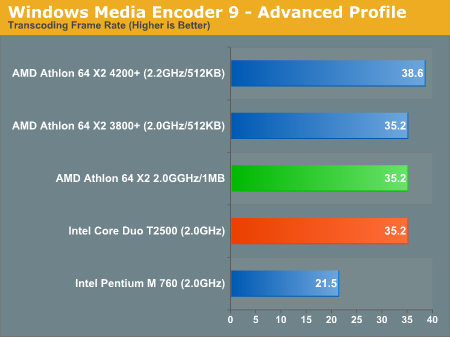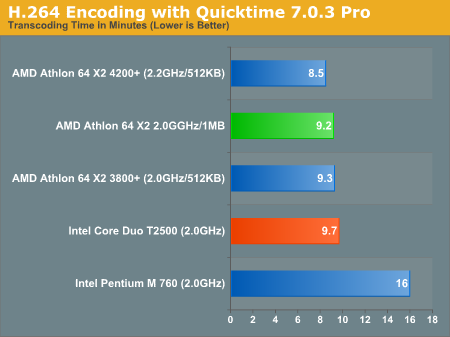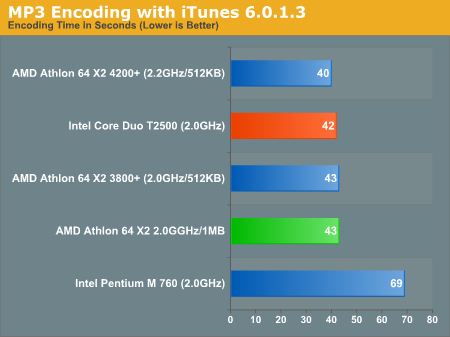Intel Core Duo (Yonah) Performance Preview - Part II
by Anand Lal Shimpi on December 19, 2005 12:55 PM EST- Posted in
- CPUs
Media Encoding Performance with DVD Shrink, WME, Quicktime and iTunes
We were most curious about the Core Duo's media encoding performance, given that a number of the optimizations for the new processor were FP/SSE related. We've updated our entire media encoding test suite, including everything from the one-click DVD ripping utility DVD Shrink to including H.264 encoding performance with Quicktime 7.0.3 Pro. We wanted to include the latest version of DivX in this comparison. However, the recent release of DivX 6.1 left us with a few bugs that we're still trying to work out in our test beds, so we had to exclude it. However, as time goes on, H.264 encoding will quickly become far more important than even looking at DivX, so its omission from this article isn't as big of a loss in terms of forward-looking performance.
First up is DVD Shrink 3.2.0.15. Our test was simple - we took a copy of Star Wars Episode VI and ripped the full DVD to the hard drive without compression, effectively giving us an exact copy of the disc on the hard drive. Then, using the copy of the DVD on the hard drive (to eliminate any DVD drive bottlenecks), we performed a DVD shrink operation to shrink the movie to fit on a single 4.5GB DVD disc. All of the options were left on their defaults, so the test ends up being pretty easy to run and reproduce. The scores reported are DVD encoding times in minutes, with lower numbers meaning better performance.
The DVD Shrink test is quite important as DVD Shrink is quite possibly one of the easiest tools to rip a DVD. The easier a tool is to use, the more likely it's going to be used, and arguably the more important performance using it happens to be.
Moving on, we have our Windows Media Encoder 9 test, which uses the advanced profile settings for video encoding. We left all settings at their defaults and just proceeded with a MPEG-2 to WMV-HD conversion. The values reported are in frames per second, with higher numbers being better.
Next up, we have Quicktime Pro 7.0.3 and we perform a MPEG-2 to H.264 encoding task. All of the settings are left at their defaults, with the exception that we optimize the output file for download with a 256kbps data rate while leaving the resolution untouched. We also adjust the video options to optimize for the best quality. We report the transcoding time in minutes, with lower values being better.
Finally, we have a MP3 encoding test using iTunes 6.0.1.3. For this test, we simply took a 304MB wav file and converted it to a 192kbps MP3 file, measuring the encode time in seconds. The only iTunes option that we changed was to prevent the playback of the song while encoding.
We were most curious about the Core Duo's media encoding performance, given that a number of the optimizations for the new processor were FP/SSE related. We've updated our entire media encoding test suite, including everything from the one-click DVD ripping utility DVD Shrink to including H.264 encoding performance with Quicktime 7.0.3 Pro. We wanted to include the latest version of DivX in this comparison. However, the recent release of DivX 6.1 left us with a few bugs that we're still trying to work out in our test beds, so we had to exclude it. However, as time goes on, H.264 encoding will quickly become far more important than even looking at DivX, so its omission from this article isn't as big of a loss in terms of forward-looking performance.
First up is DVD Shrink 3.2.0.15. Our test was simple - we took a copy of Star Wars Episode VI and ripped the full DVD to the hard drive without compression, effectively giving us an exact copy of the disc on the hard drive. Then, using the copy of the DVD on the hard drive (to eliminate any DVD drive bottlenecks), we performed a DVD shrink operation to shrink the movie to fit on a single 4.5GB DVD disc. All of the options were left on their defaults, so the test ends up being pretty easy to run and reproduce. The scores reported are DVD encoding times in minutes, with lower numbers meaning better performance.
The DVD Shrink test is quite important as DVD Shrink is quite possibly one of the easiest tools to rip a DVD. The easier a tool is to use, the more likely it's going to be used, and arguably the more important performance using it happens to be.

- The Pentium M performs exceptionally poorly, and
- The Core Duo performs exceptionally well.
Moving on, we have our Windows Media Encoder 9 test, which uses the advanced profile settings for video encoding. We left all settings at their defaults and just proceeded with a MPEG-2 to WMV-HD conversion. The values reported are in frames per second, with higher numbers being better.

Next up, we have Quicktime Pro 7.0.3 and we perform a MPEG-2 to H.264 encoding task. All of the settings are left at their defaults, with the exception that we optimize the output file for download with a 256kbps data rate while leaving the resolution untouched. We also adjust the video options to optimize for the best quality. We report the transcoding time in minutes, with lower values being better.

Finally, we have a MP3 encoding test using iTunes 6.0.1.3. For this test, we simply took a 304MB wav file and converted it to a 192kbps MP3 file, measuring the encode time in seconds. The only iTunes option that we changed was to prevent the playback of the song while encoding.

Professional Application Performance with 3dsmax, Adobe Premier and Photoshop
Gaming Performance with Battlefield 2 and Black & White 2










103 Comments
View All Comments
Furen - Monday, December 19, 2005 - link
The P6 has two FP units: An FADD unit and an FMUL unit. One of the big weaknesses of the P6 is the fact that the FMUL unit is not fully-pipelined but instead uses part of the FADD unit for FMUL operations. The K7, on the other hand, has three fully-pipelined units, an FADD, an FMUL and an FSTORE.tayhimself - Monday, December 19, 2005 - link
No he's not. AT's hardware reviewers are nublets. One thing to note though, Dothan FPU is better than the P4's hence its gaming performance advantage over the P4 in the old tests that everyone saw. It's likely that Yonah FPU is still the same as Dothan (similar to P3) and inferior to AMD's.saratoga - Monday, December 19, 2005 - link
Actually the FPU on the P4 was tremendously more powerful then Dothan or Yonah. While games do use the FPU, they're not that bottlenecked by it on modern systems. The reason Dothan did so well was because of its large, very low latency L2 cache. This is roughly equivilent to the primary advantage of the K8, a very low latency memory controller.tayhimself - Monday, December 19, 2005 - link
Youre right about the low latency L1/L2 caches on the Dothan, but the P4 (Williamette/Northwood) has those as well. But the P4 FPU is only powerful in SSE2 mode where it can load store larger chunks of data. Not all games use that unfortunately.saratoga - Monday, December 19, 2005 - link
You're wrong on several points.First:
Dothan L2 latency (clks): 10 clks
Northwood L2 latency (clks): 18 clks (approximately)
So Dothan's L2 cache is roughly 2x as fast and 4x as large. If you compare prescott with its amazingly slow L2, the situation is even more biased towards Dothan. Clearly, in terms of cache performance Dothan has a massive advantage, at least once you're out of the L1.
Second, you're confusing SSE2 and vector processing. While SSE2 can perform vector ops, it also handles plan scaler as well. In x86-64 SSE actually replaces the traditional x87 unit. The relative performance of the two is irrelevent however, the P4 was faster in both.
coldpower27 - Monday, December 19, 2005 - link
Dothan I agree with as having 10 Cycle Cache.
Northwood has 16 Cycle Cache.
Well you also got to keep in mind northwoods clock frequency plays a role in speeding up the cache, accces latencies for Dothan @ 2.0GHZ vs Northwood @ 3.2GHZ are basically equivalent. Though the 2.26GHZ Dothan has the fastest cache of all.
AlexWade - Monday, December 19, 2005 - link
Although, "Core Duo" is a stupid name. Why does Intel have to be so different? "Core Duo" is a little confusing. Is Duo a code name? What?However, despite the stupid name, we've really turned a corner in performance. Intel can make a good CPU when they realized speed isn't the future. Looks like I should start considering replacing my old Pentium-M IBM T40p with the awesome battery life.
AMD needs to respond in kind with a great new CPU. The future looks bright. Competition is once again is good for everyone.
LuxFestinus - Tuesday, December 20, 2005 - link
The ambiguously gay duo, with Ace and Gary.:) An old SNL skit.ksherman - Monday, December 19, 2005 - link
Personally, i dont like that AMD is just sitting back, seemingly waiting for Intel to catch up... They need to kick Intel while their down. these new Processors from intel look really nice and i am likely to buy one, but in a mactel laptop. I am happy for INtel that they are catching up, but AMD really NEEDS to step up and do soemthing new.Calin - Tuesday, December 20, 2005 - link
AMD's income is lower than Intel uses for R&D. You really can't expect from AMD to develop something faster than Intel can.For AMD, to have an processor they could improve a step at a time since the introduction of the Athlon64/Opteron was a need - Intel is able to mantain several teams for microprocessor development, but AMD only has money for one. And AMD will milk the market for as much as possible, selling processors that are easy to make for prices that market will accept. If AMD will start selling a higher processor grade, they would need to reduce the price for lower speed processors. This is why the 2800+ and 3000+ are discontinued - they would have to sell them too cheap.